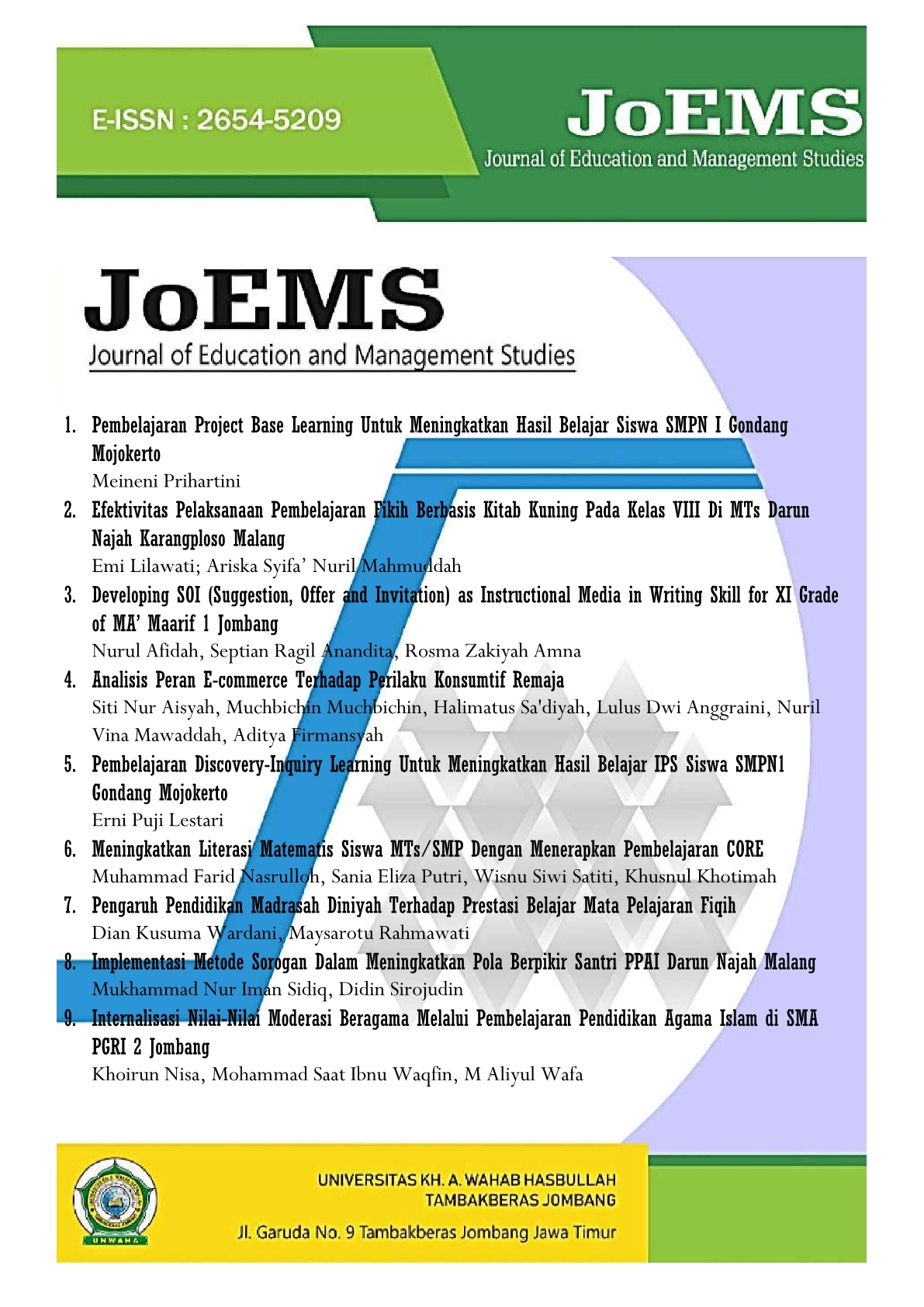Meningkatkan Literasi Matematis Siswa MTs/SMP Dengan Menerapkan Pembelajaran CORE
DOI:
https://doi.org/10.32764/joems.v6i1.812Keywords:
CORE learning model, mathematical literacy, mathematical representationAbstract
The purpose of this research was to determine the effectiveness of the CORE learning model in improving mathematical literacy of students grade 8th. This research uses pre-experimental design research method with the type of method is one-group pretest-posttest design, the research approach used is quantitative. The research instrument uses tests and non-tests. Test instruments in the form of pretest and post-test were used to measure students' mathematical literacy before and after applying CORE learning model. The non-test instrument used was an interview with a grade 8thmathematics teacher to determine the implementation of learning carried out in the classroom. The subject is class VIII D MTs Salafiyah Syafiiyah Bandung. The data analysis technique used is the paired sample t test. Based on the calculation of the paired sample t test, the resulting significance value is 0.000. The significance value shows 0.000 < 0.05 error level, so it can be concluded that Ha is accepted. This acceptance of Ha means that there are differences in the level of mathematical literacy of grade 8thMTs Salafiyah Syafiiyah Bandung before and after applying CORE learning model. This means that the CORE learning model is effective for improving students' mathematical literacy.
References
Hutagaol, K. (2013). Pembelajaran Kontekstual untuk Meningkatkan Kemampuan Representasi Matematis Siswa Sekolah Menengah Pertama.Infinity Journal, 2(1), 85–99.
Masfufah, R., & Afriansyah, E. A. (2021).Analisis kemampuan literasi matematis siswa melalui soal PISA.Mosharafa: Jurnal Pendidikan Matematika, 10(2), 291–300.
Muslimah, H., & Pujiastuti, H. (2020).Analisis Kemampuan Literasi Matematis Siswa dalam Memecahkan Masalah Matematika Berbentuk Soal Cerita.Jurnal Pendidikan Matematika dan Sains, 8(1), 36–43.
Nasrulloh, M. F., & Nurlia, Z. (2021). The Effect of the Implementation of Problem-Based Learning Models on the Mathematical Literacy Ability of Grade 7^th Student’s. Eduma : Mathematics Education Learning and Teaching, 10(2), 117–126. https://doi.org/10.24235/eduma.v10i2.8564
Nasrulloh, M. F., Satiti, W. S., & A’in -, H. (2019). Metode Tutor Sebaya Terhadap Hasil Belajar Kognitif Matematika Siswa Madrasah Aliyah Kelas X. JoEMS (Journal of Education and Management Studies), 2(1), 7–14.
National Council of Teachers of Mathematics (Ed.).(2000). Principles and Standards for School Mathematics.National Council of Teachers of Mathematics.
Nudiati, D., & Sudiapermana, E. (2020).Literasi sebagai kecakapan hidup abad 21 pada mahasiswa.Indonesian Journal of Learning Education and Counseling, 3(1), 34–40.
Nursyamsiah, G., Savitri, S., Yuspriyati, D. N., & Zanthy, L. S. (2020).Analisis Kesulitan Siswa SMP KELAS VIII Dalam Menyelesaikan Soal Materi Bangun Ruang Sisi Datar.MAJU : Jurnal Ilmiah Pendidikan Matematika, 7(1), Article 1. https://www.ejournal.stkipbbm.ac.id/index.php/mtk/article/view/436
OECD.(2019). PISA 2018 Assessment and Analytical Framework.OECD. https://doi.org/10.1787/b25efab8-en
Purwanto, P. (2018). Teknik Penyusunan Instrumen Uji Validitas Dan Reliabilitas Penelitian Ekonomi Syariah.
Puspitarini, A. (2019). Keefektifan Model Pembelajaran Core Terhadap Kemampuan Literasi Matematika Siswa Kelas VII [Other, UNNES]. http://lib.unnes.ac.id/39893/
Riyanto, Y. (2014). Paradigma Baru Pembelajaran. Jakarta: Prenadamedia group.
Santia, I. (2018). Analisis Kemampuan Literasi Matematis Siswa SMP Berdasarkan Motivasi Belajar Siswa.JIPMat, 3(2).
Sari, R. H. N. (2015). Literasi Matematika: Apa, Mengapa dan Bagaimana. Seminar Nasional matematika dan pendidikan matematika UNY, 8.
Siagian, R. E. F. (2015). Pengaruh minat dan kebiasaan belajar siswa terhadap prestasi belajar matematika.Formatif: Jurnal Ilmiah Pendidikan MIPA, 2(2).
Subandiyah, H. (2015). Pembelajaran literasi dalam mata pelajaran bahasa indonesia. Paramasastra: Jurnal Ilmiah Bahasa Sastra Dan Pembelajarannya, 2(1).
Sugiyono.(2016). Metode Penelitian Pendidikan.Bandung: Alfabeta.
Syawahid, M., & Putrawangsa, S. (2017). Kemampuan literasi matematika siswa SMP ditinjau dari gaya belajar. Beta: Jurnal Tadris Matematika, 10(2), 222–240.
Zaenuri, Z., & Dwidayanti, N. (2018). Menggali Etnomatematika: Matematika sebagai Produk Budaya. PRISMA, Prosiding Seminar Nasional Matematika, 1, 471–476.







